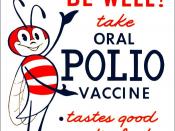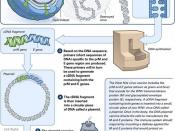Vaccines & their Functions
�
Vaccines & their Functions
Introduction
Vaccines are made from either all or portions of the microorganism against which the vaccine protects. These portions of the microorganisms are called antigens and, in most cases, are proteins, glycoproteins, or polysaccharides (Stratton, 2004). There are three traditional types of vaccines. Inactivated vaccines are made from organisms that have been killed in such a way that they still retain most of their original structure. Examples are the inactivated polio vaccine and the influenza vaccine. Live-attenuated vaccines are made of live organisms that have been weakened so that they replicate poorly in the human host and therefore do not cause disease. Examples are measles, rubella, and chickenpox vaccines. Subunit vaccines are made from only some portions of the organism. These often contain toxins that have been altered so that they are no longer dangerous, and are called toxoids, as, for example, the tetanus and the diphtheria vaccines (Levine, 2004).
Other subunit vaccines contain recombinant protein antigens, as, for example, the hepatitis B vaccine. A particular class of subunit vaccines is represented by conjugate vaccines, which consist of bacterial polysaccharides linked to protein carriers. An example is the Haemophilus influenzae type B vaccine.
Discussion
Several types of vaccines are still in the experimental stages and will be part of a new generation of vaccines in the future. These include DNA vaccines , which use the gene encoding a particular protein from an organism, and recombinant vector vaccines , which use an attenuated virus or bacterium to introduce a gene from another microorganism into the host, thus eliciting an immune response against the antigen encoded by that gene. A third type of experimental vaccine is one that does not target microorganisms, but rather is designed to aid in the elimination of...


